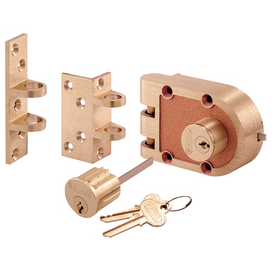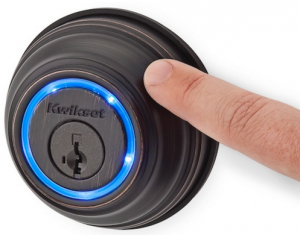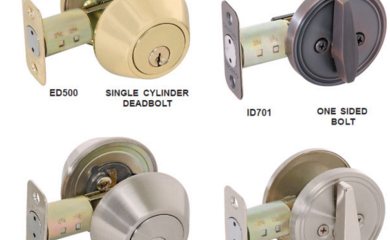Worried about the security of your home and car from burglars? Normal locks not sufficient to gain your faith in their security level? It’s time you bought a deadbolt lock. One of the most secure locks worldwide, deadbolt locks provide you with more security than the commonly used Spring-Bolt Lock.
There are three common types of deadbolt locks according to www.burbanklocksmith.org and each of them has a unique feature and is for a different purpose. It’s important to know each of these locks if you are looking forward to buying one of these for your security.
Single Cylinder Deadbolt:
This is a basic deadbolt which locks and unlocks from the outside with a key. For access from the inside you have a metal latch which lets you lock and unlock the door. This type of deadbolts is commonly used at the main entrances of households. If you are investing in a deadbolt lock for your home this is the perfect choice for you coz it restricts access from outside to a key but allows free access from the inside by the operation of a latch.
Double Cylinder Deadbolt:
 This is a more complex form of deadbolt and requires you to have a key to lock and unlock the door from both inside and outside. Considered to be more secure it is mostly used in doors with glass windows. Even if a burglar breaks the glass windows he/she cannot open the door without a key. It also imbibes in you the good habit of locking the door while closing it. However the drawback of this lock is in emergency situations like a fire. In the case of an emergency when everyone rushes to evacuate, this door can pose a problem and hence it doesn’t come up to the marks for fire safety. This type of lock is good for you if you are using a door with glasses but you must consider the fire safety norms before making a purchase.
This is a more complex form of deadbolt and requires you to have a key to lock and unlock the door from both inside and outside. Considered to be more secure it is mostly used in doors with glass windows. Even if a burglar breaks the glass windows he/she cannot open the door without a key. It also imbibes in you the good habit of locking the door while closing it. However the drawback of this lock is in emergency situations like a fire. In the case of an emergency when everyone rushes to evacuate, this door can pose a problem and hence it doesn’t come up to the marks for fire safety. This type of lock is good for you if you are using a door with glasses but you must consider the fire safety norms before making a purchase.
Keyless Entry Deadbolt:
 This type of deadbolt does not require a key as it uses a numeric keypad with a unique password to lock and unlock the door. It often also comes with a remote control which sends signals to the lock to open or close. This type of lock is used in cars. Sometimes these locks also come with a key to override the lock mechanism.
This type of deadbolt does not require a key as it uses a numeric keypad with a unique password to lock and unlock the door. It often also comes with a remote control which sends signals to the lock to open or close. This type of lock is used in cars. Sometimes these locks also come with a key to override the lock mechanism.
The Keyless Entry Deadbolt also finds massive use in the security of safes. This type of lock is designed more for your convenience. The only drawback this lock has is that it becomes null if exposed to moisture coz this is battery operated. This lock is also much more expensive than the other deadbolts. However it’s worth the buck and if you are looking for a lock for your car or safe this is just the thing for you.
Before you begin, make sure that you thoroughly read the instructions for your particular model of deadbolt. The instructions that I’m going to give you are simply general directions on how to install an everyday deadbolt lock. Your model may have an extra step, or one less, if you bought a different model. At its basics, installing a deadbolt is like installing a fancier, more secure lockset; so if you’ve ever dealt with that you should already be a step ahead of the game.
First, take the template that came with your deadbolt set and tape it around the edge of the door where you want to position the deadbolt. Ideally, you don’t want to place it less than 6 inches or further than 12 inches away from the door knob. Make sure that it is level and that the two holes for the actual deadbolt set line up on either side of the door. You can us the approximate reference points on the template for the thickness of your door. Tape it into place so that it doesn’t move. Use a pencil or an awl to mark the door where the holes should be placed.
Now, your door should be marked for where you’re going to drill. Use the hole-saw attachment and a pilot bit to drill out the door for the deadbolt. Stop drilling when the pilot bit emerges from the opposite side of the door and continue drilling from the other side. Never drill straight through your door as it will cause the wood to splinter and one side of your door will wind up looking pretty bad.
Use a smaller hole-saw attachment and drill out the hole for the bolt. Stop drilling when you reach the hole created for the deadbolt. You can use a combination square to keep you level with the door, but most power drills these days come with a level on them. Check your instruction for specifics on this step as some bolts require a different drill pattern. Once you’ve done this, put the latch plate over the bolt hole and trace its outline onto the door. Use the chisel to create a space for the latch plate making sure that it will be flush with the edge of the door. My suggestion is to work in small increments. You can always chip more away, but you can’t add more wood once it’s gone. Once this is finished, use the sandpaper to smooth out the edges of the holes and latch notch.
Now before you install the deadbolt, try assembling it. This will give you a good idea of where things are supposed to go before you have to work within the confines of the door. Once you’ve established the relationship between the locks moving parts, go ahead and install the lock. Be sure that it’s snug within the holes that you drilled for it. If it moves around inside of the holes, you may need to apply some silicone to make it fit correctly.
Now that your deadbolt is installed, you need a strike plate on the door jamb. The best way that I’ve found to accurately do this is to apply a little ink (or lipstick or paint) to the edge of your bolt. Close the door and try to turn the bolt. When you release the bolt and open the door, the ink will have perfectly marked the strike path of the bolt. This is where you’ll work.
Using the same methods that you used to install the latch plate, you’ll install the strike plate. Secure the strike plate around the ink outline of the bolt and trace the plate’s outline with your pencil. Using the same hole-saw attachment that you used to drill out the hole for the bolt, drill out the same hole in the door jamb. This will only secure an outline of the hole. Use a regular drill piece to drill out the center; if you have a spade bit, this is a great time to use it though it’s not extremely necessary. Use the chisel to carve out the mortise for the strike plate, again making sure that it will be flush with the door jamb. Drill holes for the screws then mount the strike plate to the door jamb.
Now close the door and turn the bolt into place. If it doesn’t smoothly drive into place, you may need to widen the holes or the bolt or in the door jamb. If it does, that’s great. You just made your home a bit more secure by installing a deadbolt.

